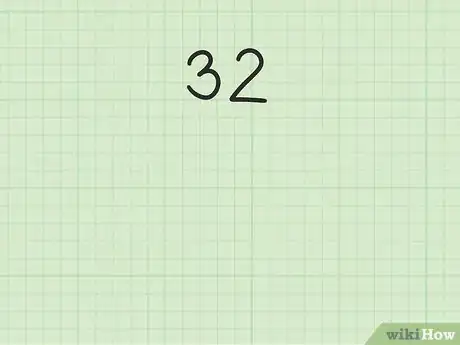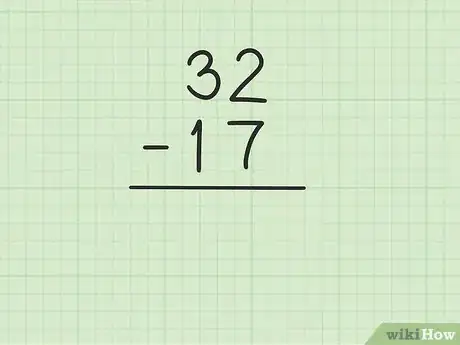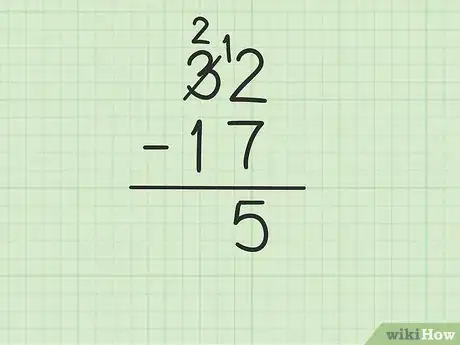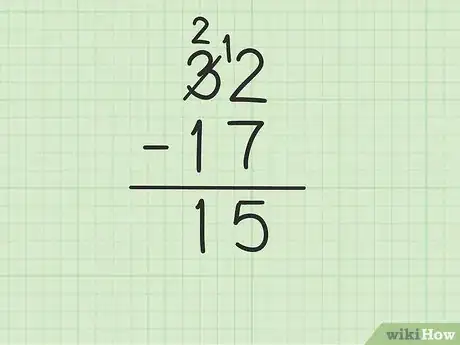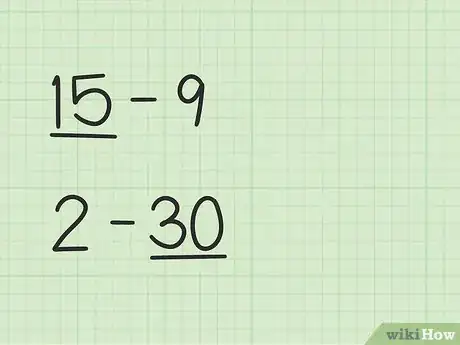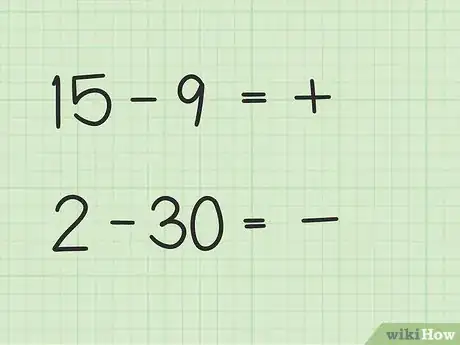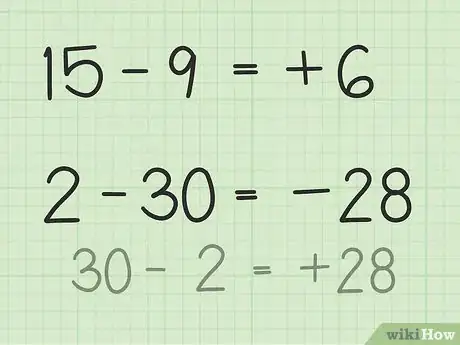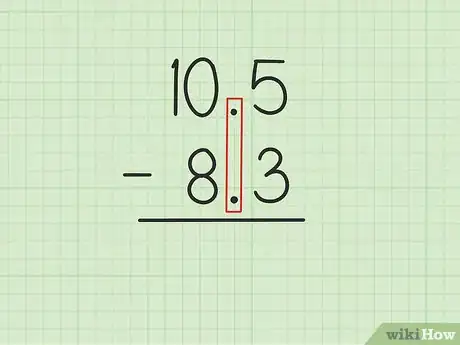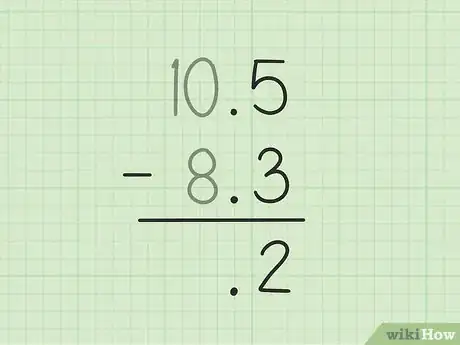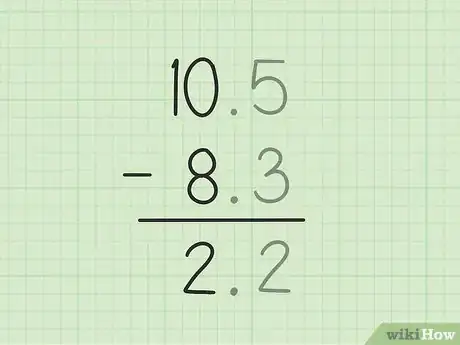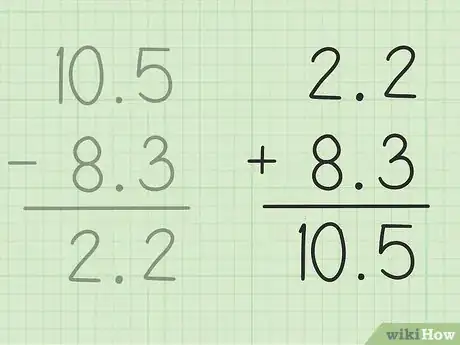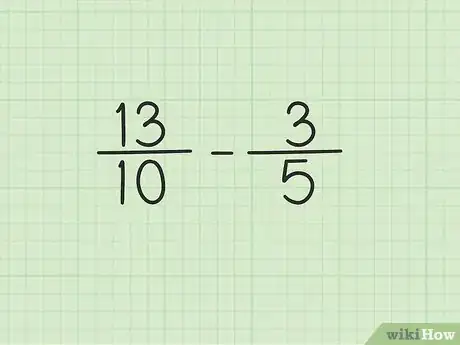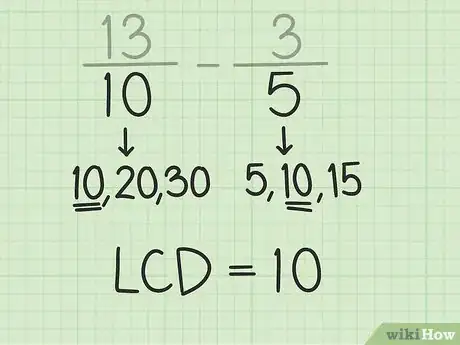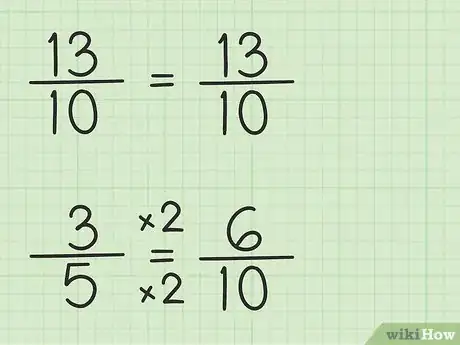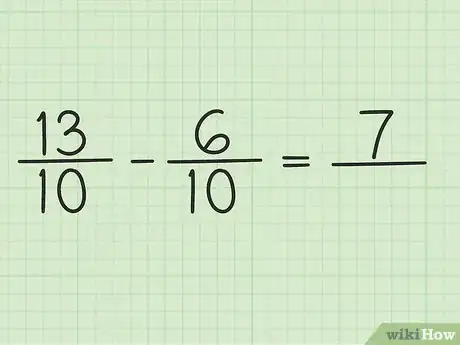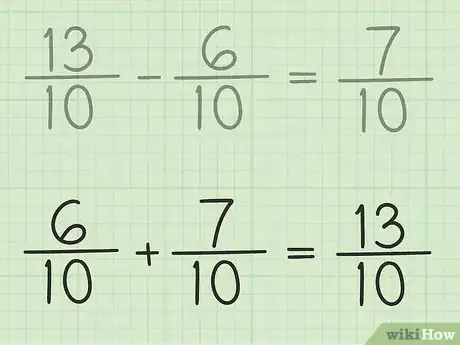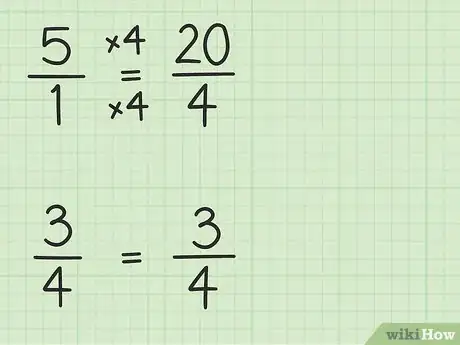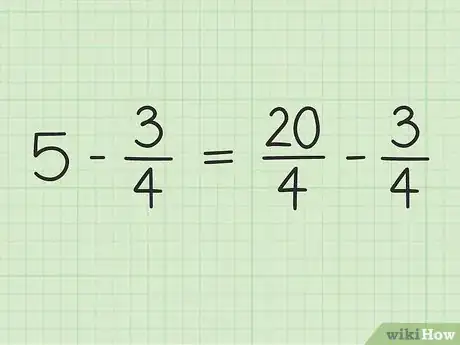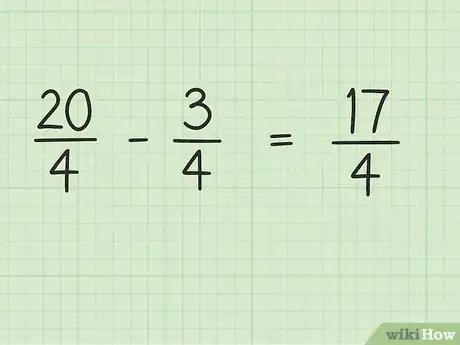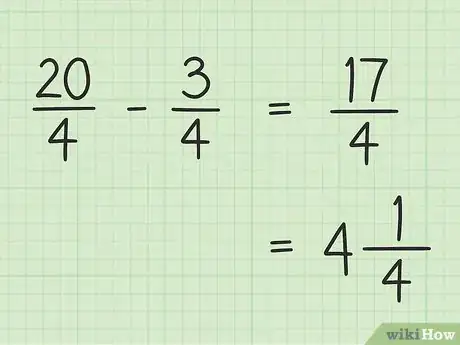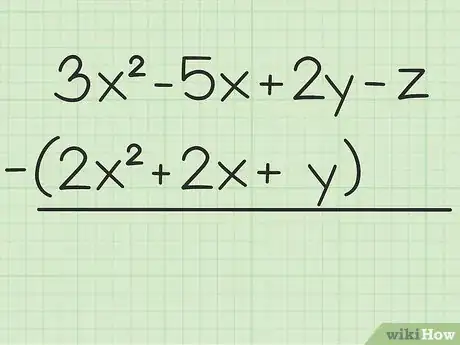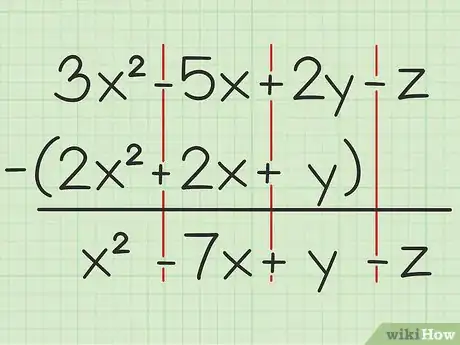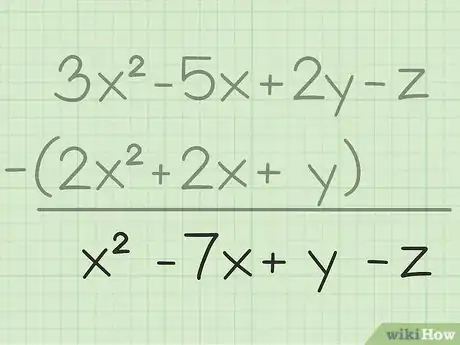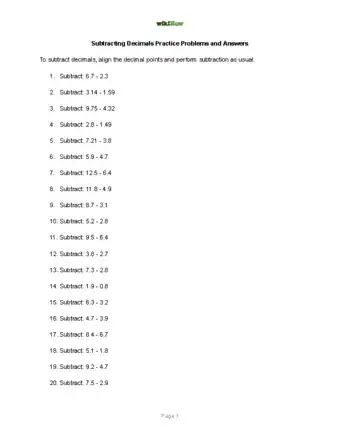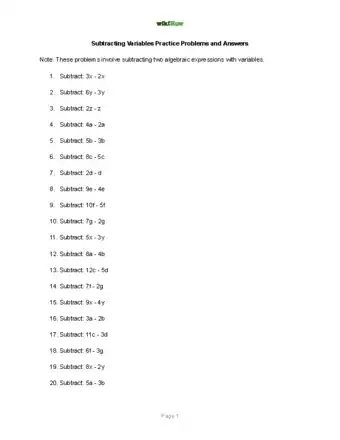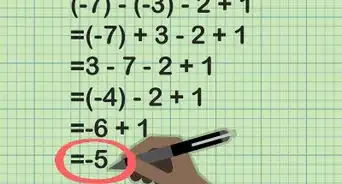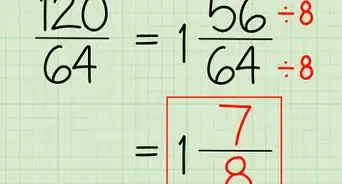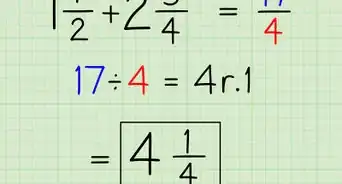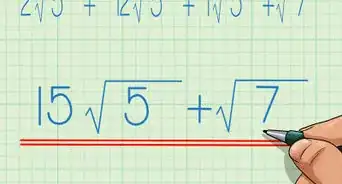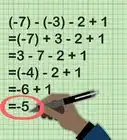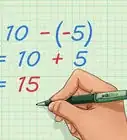This article was co-authored by David Jia. David Jia is an Academic Tutor and the Founder of LA Math Tutoring, a private tutoring company based in Los Angeles, California. With over 10 years of teaching experience, David works with students of all ages and grades in various subjects, as well as college admissions counseling and test preparation for the SAT, ACT, ISEE, and more. After attaining a perfect 800 math score and a 690 English score on the SAT, David was awarded the Dickinson Scholarship from the University of Miami, where he graduated with a Bachelor’s degree in Business Administration. Additionally, David has worked as an instructor for online videos for textbook companies such as Larson Texts, Big Ideas Learning, and Big Ideas Math.
There are 14 references cited in this article, which can be found at the bottom of the page.
This article has been viewed 463,052 times.
Subtraction is simply taking one number away from the other. It's pretty straightforward when you're subtracting one whole number from another, but subtraction can get a bit more complicated when you're working with fractions or decimals. Once you get the hang of subtraction, you'll be able to move on to more complicated mathematical concepts, and will be able to add, multiply, and divide numbers with greater ease.
Steps
Subtracting Larger Whole Numbers by Borrowing
-
1Write down the larger number. Let's say you're working with the problem 32 - 17. Write down 32 first.
-
2Write the smaller number directly below it. Make sure that you line up the tens and ones columns, so that the 3 in "32" is directly above the 1 in "17" and that the 2 in "32" is directly above the "7" in 17.[1]Advertisement
-
3Subtract the number in the ones column of the bottom number from the number in the ones column of the top number. Now, this can get a little bit tricky when the bottom number is larger than the top number. In this case, 7 is larger than 2. Here's what you need to do:[2]
- You'll need to "borrow" from the 3 in "32" (also known as regrouping), in order to turn that 2 into a 12.
- Cross off the 3 in "32" and make it a 2, while making the 2 a 12.
- Now, you have 12 - 7, which is equal to 5. Write a 5 below the two numbers you subtracted, so it lines up with the ones column in a new row.
-
4Subtract the number in the tens column of the bottom number from the number in the tens column of the top number.[3] Remember that your 3 is now a 2. Now, subtract the 1 in 17 from the 2 above it to get (2-1) 1. Write 1 below the numbers in the tens columns, to the left of the 5 in the ones column of the answer. You should have written 15. This means that 32 - 17 = 15.
-
5Check your work. If you want to be sure that you correctly subtracted the two numbers, then all you have to do is to add the answer to the smaller number to make sure that you get the larger number. In this case, you should add your answer, 15, to the smaller number in the subtraction number, 17. 15 + 17 = 32, so you've done your work correctly. Well done!
Subtracting Small Whole Numbers
-
1Identify which number is larger. A problem such as 15 - 9 will need a different visualization technique than a problem like 2 - 30.
- In the problem 15 - 9, the first number, 15, is larger than the second, 9.
- In the problem 2 - 30, the second number, 30, is larger than the first, 2.
-
2Decide whether your answer will be positive or negative. If the first number is larger, the answer is positive. If the second number is larger, the answer will be negative.
- In the first problem, 15 - 9, your answer will be positive because the first number is larger than the second.
- In the second problem, 2 - 30, your answer will be negative because the second number is larger than the first.
-
3Find the gap between the two numbers. In order to subtract the two numbers, you'll have to visualize the gap between the two numbers and count the numbers in between.[4]
- For the problem 15 - 9, visualize a pile of 15 poker chips. Remove 9 of them and you'll see that 6 of them remain. Therefore, 15 - 9 = 6. You can also think of a number line. Think of the numbers from 1 to 15 and then remove or go back 9 units to get 6.
- For the problem 2 - 30, the easiest thing to do is to reverse the numbers and then make the answer negative after you've subtracted them. So, 30 - 2 = 28, since 28 is just two less than 30. Now, make your answer negative since you determined at the beginning that it would be negative because the second number is larger than the first. Therefore, 2 - 30 = -28.
Subtracting Decimals
-
1Write the larger number over the smaller number with the decimals lined up.[5] Let's say you're working with the following problem: 10.5 - 8.3. Write 10.5 above 8.3 so that the decimal points of both numbers are lined up. The .5 in 10.5 should be over the .3 in 8.3, and the 0 in 10.5 should be over the 8 in 8.3.
- If you have a problem where both numbers don't have the same amount of numbers after the decimal point, write a 0 in the empty spaces until they even out. For example, if you have the problem 5.32 - 4.2, you can rewrite it as 5.32 - 4.20. This won't change the value of the second number while making it possible to subtract both numbers more easily.
-
2Subtract the number in the tenths column of the bottom number from the number in the tenths column of the top number. You should follow the same process you'd follow when subtracting regular whole numbers, except that you need to remember to line up the decimals of both numbers and to keep the decimal in your answer. In this case, you need to subtract 3 from 5. 5 - 3 = 2, so you should write a 2 below the 3 in 8.3.[6]
- Make sure to carry that decimal point down to the answer. It should read .2 so far.
-
3Subtract the number in the ones column of the bottom number from the number in the ones column of the top number. Now, you'll need to subtract 8 from 0. Borrow from the 1 next to the 0 to make it a 10, and subtract 8 from 10 (10 - 8) to get 2. You can also just think of it as subtracting 8 from 10 without borrowing since there's no number in the tens column of the second number. Write the answer down below the 8, to the left of the decimal point.[7]
-
4State your final answer. Your final answer is 2.2.
-
5Check your work. If you want to make sure you subtracted decimals correctly, then all you have to do is to add your answer and the smaller number to make sure that you get the larger number. 2.2 + 8.3 = 10.5 so you're all done.
Subtracting Fractions
-
1Line up the denominators and the numerators of the fractions. Let's say you're working with the problem 13/10 - 3/5. Write down the problem so that both numerators, 13 and 3, and both denominators, 10 and 5, are directly across from each other. The two numbers will be separated by a subtraction sign. This will help you visualize the problem and reach a solution more easily.[8]
-
2Find the lowest common denominator. The lowest common denominator is the smallest number that is evenly divisible by both numbers. In this example, you'll need to find the lowest common denominator of the numbers 10 and 5. You can see that 10 is the lowest common denominator of both numbers, because 10 is evenly divisible by both 10 and 5.[9]
- Note that the lowest common denominator of two numbers isn't always one of the numbers. For example, the lowest common denominator of the numbers 3 and 2 is 6, because that's the smallest number that is evenly divisible by both numbers.
-
3Rewrite the fractions with the same denominators. The fraction 13/10 can be written the same way, since the denominator, 10, goes into the lowest common denominator, 10, exactly 1 time. However, the fraction 3/5 needs to be rewritten because the denominator, 5, goes into the lowest common denominator, 10, 2 times. So, the fraction 3/5 needs to be multiplied by 2/2 in order to have 10 in the denominator. therefore, 3/5 x 2/2 = 6/10. You've created an equivalent fraction. 3/5 is equal to 6/10, though 6/10 allows you to subtract the number from the first number, 13/10.[10]
- Write the new problem like this: 13/10 - 6/10.
-
4Subtract the numerators of both fractions. Simply subtract 13 - 6 to get 7. You should not change the denominators of the fractions.
-
5Write the new numerator over the same denominator to get your final answer.[11] Your new numerator is 7. Both fractions have the denominator 10. Your final answer is therefore 7/10.
-
6Check your work. If you want to make sure that you subtracted the fractions correctly, just add up your answer and the smaller fraction to make sure that your answer is the larger fraction. So, 7/10 + 6/10 = 13/10. You're all done.
Subtracting a Fraction from a Whole Number
-
1Write down the problem. Let's say you're working with the following problem: 5 - 3/4. Write it down.[12]
-
2Turn the whole number into a fraction with the same denominator as the fraction. You'll want to convert the number 5 into a fraction with the denominator of 4 in order to subtract the two numbers. So, you can first think of 5 as a fraction that is really 5/1. Then, you can multiply both the top and bottom of the new fraction by 4 in order to create two fractions with the same denominator. So, 5/1 x 4/4 = 20/4. This fraction is really equal to 5, but it allows you to subtract two fractions.[13]
-
3Rewrite the problem. The new problem can be written like this: 20/4 - 3/4.[14]
-
4Subtract the numerators of the fractions while keeping the denominator the same. Now, you can simply subtract 3 from 20 to get the final answer. 20 - 3 = 17, so 17 is your new numerator. You can keep the denominator as it is.[15]
-
5Write your final answer. Your final answer is 17/4. If you'd like to state it as a mixed number, simply divide 17 by 4 to get 4, with 1 left over as the remainder. This will make your final answer 17/4 equal to 4 1/4.
Subtracting Variables
-
1Write down the problem. Let's say you're working with the following problem: 3x2 - 5x + 2y - z - (2x2 + 2x + y). Write the first set of terms above the second.[16]
-
2Subtract like terms. When you're working with variables, you can only add or subtract terms that have the same variable and which are written to the same degree.[17] This means that you can subtract 4x2 from 7x2, for example, but not 4x from 4y. This means that you can break the problem down like this:
- 3x2 - 2x2 = x2
- -5x - 2x = -7x
- 2y - y = y
- -z - 0 = -z
-
3State your final answer. Now that you've subtracted all of the like terms you can subtract, all you can do is state your final answer, which will contain each of the terms that you subtracted. Here's the final answer:
- 3x2 - 5x + 2y - z - (2x2 + 2x + y) = x2 - 7x + y - z
Practice Problems and Answers
Community Q&A
-
QuestionWhat about subtracting larger numbers from smaller numbers? For example, 1.2 - 4.7. Is there an easy way to do this, going into negatives?
 DonaganTop AnswererYou subtract the smaller number from the larger number and put a negative sign in front of the answer.
DonaganTop AnswererYou subtract the smaller number from the larger number and put a negative sign in front of the answer. -
QuestionHow do I subtract 3-digit numbers?
 DonaganTop AnswererDo it the way it's shown above with two-digit numbers, but continue the same process into the hundreds column.
DonaganTop AnswererDo it the way it's shown above with two-digit numbers, but continue the same process into the hundreds column. -
QuestionHow do I borrow when the top number is a 0?
 Community AnswerWhen the top number is a 0, you go to the next number to the left, borrow 1 from that number, and turn the 0 into a 10.
Community AnswerWhen the top number is a 0, you go to the next number to the left, borrow 1 from that number, and turn the 0 into a 10.
Warnings
- If you have a mixture of positive and negative numbers, things get considerably more complicated. Please consult the wikiHow article How to Add and Subtract Integers⧼thumbs_response⧽
References
- ↑ https://www.mathsisfun.com/numbers/subtraction-regrouping.html
- ↑ https://www.mathsisfun.com/numbers/subtraction-regrouping.html
- ↑ https://www.mathsisfun.com/numbers/subtraction-regrouping.html
- ↑ https://ltcconline.net/greenl/courses/187/a/WholeNumberSubtract.htm
- ↑ https://www.mathsisfun.com/subtracting-decimals.html
- ↑ https://www.mathsisfun.com/subtracting-decimals.html
- ↑ https://www.khanacademy.org/math/arithmetic/arith-decimals/arith-review-sub-decimals/v/subtracting-decimals
- ↑ https://www.mathsisfun.com/fractions_subtraction.html
- ↑ https://www.bbc.co.uk/bitesize/topics/zsxhfg8/articles/z4rhsrd
- ↑ https://www.bbc.com/bitesize/articles/z9n4k7h
- ↑ https://www.cuemath.com/numbers/subtraction-of-fractions/
- ↑ https://mathwizz.com/fractions/help/help11.htm
- ↑ https://www.cuemath.com/questions/how-do-you-subtract-a-fraction-from-a-whole-number/
- ↑ https://virtualnerd.com/algebra-1/algebra-foundations/real-number-add-subtract/real-number-subtract/subtract-whole-number-from-fraction
- ↑ https://virtualnerd.com/algebra-1/algebra-foundations/real-number-add-subtract/real-number-subtract/subtract-whole-number-from-fraction
- ↑ https://www.khanacademy.org/math/algebra/introduction-to-polynomial-expressions/add-subtract-poly-two-var/v/subtracting-polynomials-with-multiple-variables
- ↑ https://www.khanacademy.org/math/algebra-home/alg-polynomials/alg-add-subtract-poly-two-var/v/subtracting-polynomials-with-multiple-variables
- http://www.mathsisfun.com/numbers/subtraction-regrouping.html
About This Article
To subtract large whole numbers, write down the larger number first and put the smaller number directly below it. Next, subtract the number in the ones column of the bottom number from the number in the ones column of the top number. Then, subtract the number in the tens column of the bottom number from the number in the tens column of the top number to get your final answer! For tips on subtracting decimals, fractions, and variables, read on!
